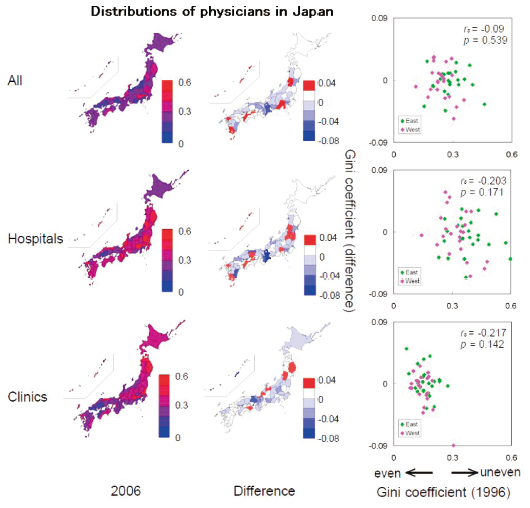メディカルバイオサイエンス学科
 永田 宏(ながた・ひろし)
永田 宏(ながた・ひろし)
Hiroshi Nagata
専門分野/医療情報学、医療経済学研究キーワード/医療情報、医療制度、医療情報システム
職位:教授
学位:博士(医学)(東京医科歯科大学)
- 筑波大学理工学研究科修士課程修了
- オリンパス光学工業(株)、(株)KDDI研究所、タケダライフサイエンスリサーチセンター客員研究員、鈴鹿医療科学大学医用工学部教授を歴任
研究テーマ
(1)医療崩壊の現状分析と対策

日本は1980年代後半から医学部定員削減政策を採ってきたため、現在深刻な医師不足に陥っている。また都市部と農村部の医師の偏在、診療科目間の医師の偏在が進んでいる。その一方で診療報酬の減額等により多くの病院が赤字経営に陥っており、国全体としての医療崩壊が進行しつつある。しかし医療崩壊の実態がまだ数字的に明らかになっていないことから、政府の統計資料等を活用しつつ、詳細な分析を行っているところである。
(2) 日本版EHR・PHRのフィージビリティ・スタディ
いう動きもある。こうした情報化を支える情報基盤として、EHR(Electronic Health Records) やPHR(Personal HealthRecords) と呼ばれるシステムの構築が始まっている。日本でも同様の検討がなされており、現在は技術的・制度的フィージビリティ(実現可能性)の検討を進めているところである。
(3)民間医療保険の在り方の研究
がん保険をはじめとする民間医療保険が人気を集めているが、その保障内容や保険料の妥当性に関する研究はほとんどなされていない。しかし病気に罹る確率や平均的医療費などを含む医療統計データは豊富に存在する。そこで医療統計学的にみた民間医療保険の問題点を消費者の視点から分析している。またゲノム時代に適した医療保険の在り方についても同時に研究を進めている。
| 研究の応用領域 | 産官学連携で求めるパートナー |
|---|---|
| 自治体における医療計画 民間病院の患者マーケティング |
自治体の医療担当部門 民間病院の経営部門 |
Topics of research
1. Statistical analysis of collapse of healthcare systems in Japan
In Japan, doctor shortage has been advanced because of the reduction policy of number of students entering medical schools. Also uneven distribution of physicians between urban and rural areas and between busy clinical subjects (such as OB and PD) and relatively soft subjects (ophthalmology, psychosomatic, dermatology and so on) has been seriously expanding. In addition, most hospitals have def icits because the government has been suppressed the medical expenses. As the result, Japanese health care system faces a grave crisis. We are investigating the situation of the collapses by using medical statistics of the government.
2. Feasibility studies to realize EHR/PHR systems
EHR(Electronic Health Records) and PHR(Personal Health Records), which are such like life log systems of personal medical and health information to help clinical and health managements, are being developed in many countries. The Ministry of Health, Labor and Welfare of Japan is also aiming to realize such systems. We are corroborating with doctors and researchers of many other hospitals and universities to study feasibility of EHR and PHR systems in Japan.
3. Comparative studies of private health insurances
Japan adopts the universal health insurance which is the public insurance to cover clinical costs of most of all medical treatments. In Japan, the individual pays only 30% of the treatment cost, and the remaining 70% is paid by the public health insurance. However, recently a growing number of people join private health insurances to compensate for the individual medical costs. We are analyzing the pros and cons of private medical costs by using medical statistical methods.
主な業績論文等
- Shibata M, Niimura Y, Nagata H, Tanaka H. The trends of physician distribution in Japan from 1996 to 2006 (to be published)
- Okamoto E, Fujii H, Tanaka H, Yamakata D, Nobutomo K, Nagata H. Development of an IT Infrastructure under Japan’s Health Care Reform 2008. Japan Journal of Medical Informatics, 28(2), 93-98 (2008)
- Sima Y, Suwa A, Gomi Y, Nogawa H, Nagata H, Tanaka H. Qualitative and quantitative assessment of video transmitted by DVTS in surgical telemedicine. Journal of Telemedicine and Telecare. 13, 148-53 (2007)
- Okada I, Ohnishi T, Nagata H, Tanaka H, Mizushima H. Portable virtual reality system using haptic device and naked eye 3D display, for molecular modeling. Conference Proceedings of ISMB05 (2005)






